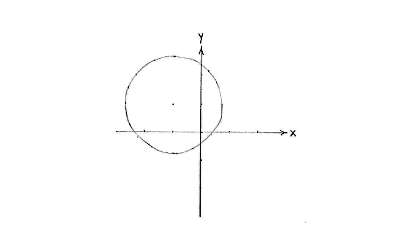Lösung 4.1:7a
Aus Online Mathematik Brückenkurs 1
(Unterschied zwischen Versionen)
K |
K (Robot: Automated text replacement (-{{Displayed math +{{Abgesetzte Formel)) |
||
| Zeile 1: | Zeile 1: | ||
As the equation stands, it is difficult directly to know anything about the circle, but if we complete the square and combine ''x''- and ''y''-terms together in their own respective square terms, then we will have the equation in the standard form | As the equation stands, it is difficult directly to know anything about the circle, but if we complete the square and combine ''x''- and ''y''-terms together in their own respective square terms, then we will have the equation in the standard form | ||
| - | {{ | + | {{Abgesetzte Formel||<math>(x-a)^2 + (y-b)^2 = r^2\,,</math>}} |
and we will then be able to read off the circle's centre and radius. | and we will then be able to read off the circle's centre and radius. | ||
| Zeile 7: | Zeile 7: | ||
If we take the ''x''- and ''y''-terms on the left-hand side and complete the square, we get | If we take the ''x''- and ''y''-terms on the left-hand side and complete the square, we get | ||
| - | {{ | + | {{Abgesetzte Formel||<math>\begin{align} |
x^2 + 2x &= (x+1)^2-1^2\,,\\[5pt] | x^2 + 2x &= (x+1)^2-1^2\,,\\[5pt] | ||
y^2 - 2y &= (y-1)^2-1^2\,, | y^2 - 2y &= (y-1)^2-1^2\,, | ||
| Zeile 14: | Zeile 14: | ||
and then the whole equation can be written as | and then the whole equation can be written as | ||
| - | {{ | + | {{Abgesetzte Formel||<math>(x+1)^2 - 1^2 + (y-1)^2 - 1^2 = 1\,,</math>}} |
or, with the constants moved to the right-hand side, | or, with the constants moved to the right-hand side, | ||
| - | {{ | + | {{Abgesetzte Formel||<math>(x+1)^2 + (y-1)^2 = 3\,\textrm{.}</math>}} |
This is a circle having its centre at (-1,1) and radius <math>\sqrt{3}\,</math>. | This is a circle having its centre at (-1,1) and radius <math>\sqrt{3}\,</math>. | ||
Version vom 08:49, 22. Okt. 2008
As the equation stands, it is difficult directly to know anything about the circle, but if we complete the square and combine x- and y-terms together in their own respective square terms, then we will have the equation in the standard form
| \displaystyle (x-a)^2 + (y-b)^2 = r^2\,, |
and we will then be able to read off the circle's centre and radius.
If we take the x- and y-terms on the left-hand side and complete the square, we get
| \displaystyle \begin{align}
x^2 + 2x &= (x+1)^2-1^2\,,\\[5pt] y^2 - 2y &= (y-1)^2-1^2\,, \end{align} |
and then the whole equation can be written as
| \displaystyle (x+1)^2 - 1^2 + (y-1)^2 - 1^2 = 1\,, |
or, with the constants moved to the right-hand side,
| \displaystyle (x+1)^2 + (y-1)^2 = 3\,\textrm{.} |
This is a circle having its centre at (-1,1) and radius \displaystyle \sqrt{3}\,.

